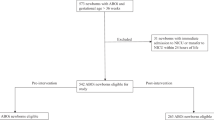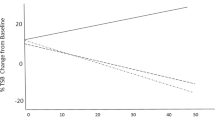Abstract
OBJECTIVE:
The objective of the study was to determine whether initiation of early phototherapy in positive direct Coombs' test (DCT) with ABO-incompatible newborns would prevent severe jaundice.
STUDY DESIGN:
A prospective controlled study was performed at Al Qassimi Hospital. Infants born at term and weighing >2000 g with ABO incompatibility and a positive DCT were included in the study. Within their first 4 hours of life and after parental consent, infants were enrolled into one of two groups: prophylactic phototherapy group, which received phototherapy during the first 24 hours of life (group I), or no prophylactic phototherapy, which represents the control group (group II). Selection of infants to either group was by 2-week alternative strategy.
Blood group, complete blood count (CBC), reticulocyte count, blood smears, total serum bilirubin (TSB) and DCT were performed on cord blood of all neonates born to mothers with O-positive blood group. CBC, reticulocytes and TSB level were obtained in all enrolled infants at 12, 24, 48, 72, and 96 hours of life.
RESULTS:
During the study period, 242 newborns with positive DCT were enrolled. A total of 102 infants were allocated to the prophylactic phototherapy arm and 140 as controls.
Prophylactic phototherapy was associated with a significant decrease in the TSB at 24 hours (p=0.002) and at 48 hours (p=0.003) but not later on. The total number of patients who had hyperbilirubinemia at any time during the first 96 hours was significantly less in the prophylactic group (17 vs 45 — p=0.006). Prolonged hospital stay because of phototherapy was more frequent in the control group (p=0.03).
CONCLUSION:
Prophylactic phototherapy was associated with a significant reduction of TSB in the first 48 hours of life but not later on. Clinical benefits of this strategy could not be proven.
This is a preview of subscription content, access via your institution
Access options
Subscribe to this journal
Receive 12 print issues and online access
$259.00 per year
only $21.58 per issue
Buy this article
- Purchase on Springer Link
- Instant access to full article PDF
Prices may be subject to local taxes which are calculated during checkout
Similar content being viewed by others
References
Maisels J, Kring E . Length of stay, jaundice and hospital readmission. Pediatrics 1998;101:995–998.
Mitchell S, Mathura N . Identifying infants who might benefit from routine measurement of bilirubin during first 48–72 hours of life. BMJ 2000;320:119.
Stoll B, Kliegman R . Blood disorders. In: Behrman R, Kliegman R, Jenson H, editors. Nelson Textbook of Pediatrics. 17th ed. Pennsylvania: Saunders Co.; 2004. p. 599–608.
Sarici SU, Yurdakok M, Serdan MA . An early 6-hour serum bilirubin measurement is useful in predicting the development of significant hyperbilirubinemia and severe ABO hemolytic disease. Pediatrics 2002;109:e53.
Orzalesi M, Gloria F, Lucarelli P, Bottini E . ABO system incompatibility: relationship between direct Coombs' test positivity and neonatal jaundice. Pediatrics 1973;51:288–289.
Maisels MJ, Newman TB . Kernicterus in otherwise healthy, breast-fed term newborns. Pediatrics 1995;96:730–733.
Osborn LM, Lenarsky C, Oakes R, Reiff M . Phototherapy in full term infants with hemolytic disease secondary to ABO incompatibility. Pediatrics 1984;74:371–374.
Bhutani VK, Johnson L, Sivieri EM . Predictive ability of pre-discharge hour-specific serum bilirubin for subsequent significant hyperbilirubinemia in healthy and near-term newborns. Pediatrics 1999;103:6–14.
Stanley IP, Chung M, Kulig J, et al. An evidence-based review of important issues concerning neonatal hyperbilirubinemia. Peditatrics 2004;114:e130–e153.
Brown AK, Kim MH, Wu YK, Bryla DA . Efficacy of phototherapy in prevention and management of neonatal hyperbilirubinemia. Pediatrics 1985;75:393–400.
Maurer HM, Kirkpatrick BV, Me Williams NB . Phototherapy for hyperbilirubinemia of hemolytic disease of the newborn. Pediatrics 1985;75:407–412.
Subcommittee on hyperbilirubinemia in the newborn infant 35 or more weeks of gestation. Pediatrics 2004;114:297–316.
Risemberg HM, Mazzi E, Macdonald MG, Heldrich F . Correlation of cord bilirubin levels with hyperbilirubinemia in ABO incompatibility. Arch Dis Child 1977;52:219–222.
Chen JY, Chung H . Prediction of the development of neonatal hyperbilirubinemia in ABO incompatibility. Chin Med J 1994;53:13–18.
Levine D, Meyer B . Newborn screening for ABO haemolytic disease. Clin Paediatr 1985;24:391–394.
Alpay F, Sarici SU, Tosuncuk HD, Serdar MA . The value of first-day bilirubin measurement in predicting the development of significant hyperbilirubinemia in healthy term newborns. Pediatrics 2000;106:e16.
Acknowledgements
We extend our thanks and gratitude to Pr. Khalid Haque Reader in Neonatal Pediatrics, University of London and Consultant Neonatologist at Queen Mary children hospital in UK, and to Professors Arne Ohlsson and Balf from the University of Toronto for their helpful comments. We also thank Ms. Noha Yaseen for typing this manuscript.
Author information
Authors and Affiliations
Rights and permissions
About this article
Cite this article
Yaseen, H., Khalaf, M., Rashid, N. et al. Does Prophylactic Phototherapy Prevent Hyperbilirubinemia in Neonates with ABO Incompatibility and Positive Coombs' Test?. J Perinatol 25, 590–594 (2005). https://doi.org/10.1038/sj.jp.7211356
Published:
Issue Date:
DOI: https://doi.org/10.1038/sj.jp.7211356
This article is cited by
-
Intravenous Immunoglobulin G Treatment in ABO Hemolytic Disease of the Newborn, is it Myth or Real?
Indian Journal of Hematology and Blood Transfusion (2014)
-
Prophylactic Phototherapy in ABO Incompatibility
Journal of Perinatology (2005)



